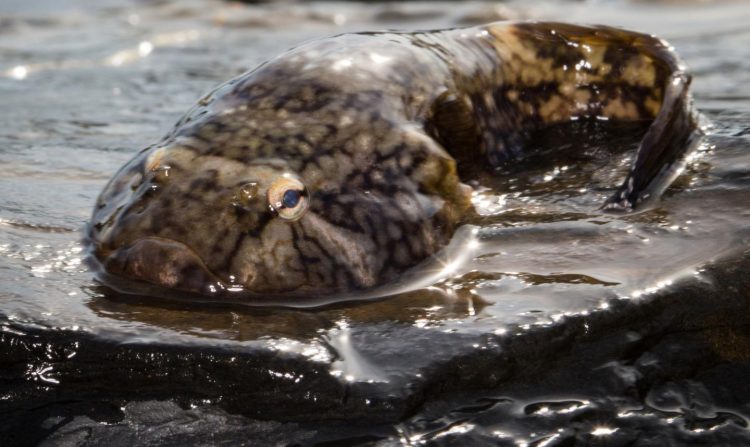Puget Sound's clingfish could inspire better medical devices, whale tags

A Northern clingfish is shown in its natural environment. Credit: Petra Ditsche, U of Washington
It's called the Northern clingfish, and its small, finger-sized body uses suction forces to hold up to 150 times its own body weight. These fish actually hold on better to rough surfaces than to smooth ones, putting to shame industrial suction devices that give way with the slightest uneven surface.
Researchers at the University of Washington's Friday Harbor Laboratories on San Juan Island are studying this quirky little fish to understand how it can summon such massive suction power in wet, slimy environments. They are beginning to look at how the biomechanics of clingfish could be helpful in designing devices and instruments to be used in surgery and even to tag and track whales in the ocean.
“Northern clingfish's attachment abilities are very desirable for technical applications, and this fish can provide an excellent model for strongly and reversibly attaching to rough, fouled surfaces in wet environments,” said Petra Ditsche, a postdoctoral researcher with Adam Summers' team at Friday Harbor Labs.
Ditsche presented her research on the sticky benefits of clingfish last month in Nashville at the Adhesive and Sealant Council's spring convention in a talk, “Bio-inspired suction attachment from the sea.”
Clingfish have a disc on their bellies that is key to how they can hold on with such tenacity. The rim of the disc is covered with layers of micro-sized, hairlike structures. This layered effect allows the fish to stick to surfaces with different amounts of roughness.
“Moreover, the whole disc is elastic and that enables it to adapt to a certain degree on the coarser sites,” Ditsche added.
Many marine animals can stick strongly to underwater surfaces – sea stars, mussels and anemones, to name a few – but few can release as fast as the clingfish, particularly after generating so much sticking power.
On land, lizards, beetles, spiders and ants also employ attachment forces to be able to move up walls and along the ceiling, despite the force of gravity. But unlike animals that live in the water, they don't have to deal with changing currents and other flow dynamics that make it harder to grab on and maintain a tight grip. (Read a recent paper by Ditsche and Summers on the differences between adhesion in water and on land.)
Clingfish's unique ability to hold with great force on wet, often slimy surfaces makes them particularly intriguing to study for biomedical applications. Imagine a bio-inspired device that could stick to organs or tissues without harming the patient.
“The ability to retract delicate tissues without clamping them is desirable in the field of laparoscopic surgery,” Summers said. “A clingfish-based suction cup could lead to a new way to manipulate organs in the gut cavity without risking puncture.”
Researchers are also interested in developing a tagging tool for whales that would allow a tag to noninvasively stick to the animal's body instead of puncturing the skin with a dart, which is often used for longer-term tagging.
Ditsche, Summers and the UW graduate and undergraduate students who are studying the Northern clingfish have no shortage of specimens to choose from. This species is found in the coastal waters near Mexico all the way up to Southern Alaska. They often cling to the rocks near the shore, and at low tide the researchers can poke around in tide pools and turn over rocks to collect the fish. If they can unstick them, that is.
There are about 110 known species in the clingfish family found all over the world. The population around the San Juan Islands is robust and healthy.
Now that they have measured the strength of the suction on different surfaces, the researchers plan to look next at how long clingfish can stick to a surface. They also want to understand why bigger clingfish can stick better than smaller ones, and what implications that could have on developing materials based on their properties.
This research is funded by the National Science Foundation and the Seaver Foundation.
For more information, contact Ditsche at pditsche@uw.edu or 360-610-0860.
Media Contact
All latest news from the category: Life Sciences and Chemistry
Articles and reports from the Life Sciences and chemistry area deal with applied and basic research into modern biology, chemistry and human medicine.
Valuable information can be found on a range of life sciences fields including bacteriology, biochemistry, bionics, bioinformatics, biophysics, biotechnology, genetics, geobotany, human biology, marine biology, microbiology, molecular biology, cellular biology, zoology, bioinorganic chemistry, microchemistry and environmental chemistry.
Newest articles

Compact LCOS Microdisplay with Fast CMOS Backplane
…for High-Speed Light Modulation. Researchers from the Fraunhofer Institute for Photonic Microsystems IPMS, in collaboration with HOLOEYE Photonics AG, have developed a compact LCOS microdisplay with high refresh rates that…

New perspectives for material detection
CRC MARIE enters third funding period: A major success for terahertz research: Scientists at the University of Duisburg-Essen and the Ruhr University Bochum have been researching mobile material detection since…

CD Laboratory at TU Graz Researches New Semiconductor Materials
Using energy- and resource-saving methods, a research team at the Institute of Inorganic Chemistry at TU Graz aims to produce high-quality doped silicon layers for the electronics and solar industries….



